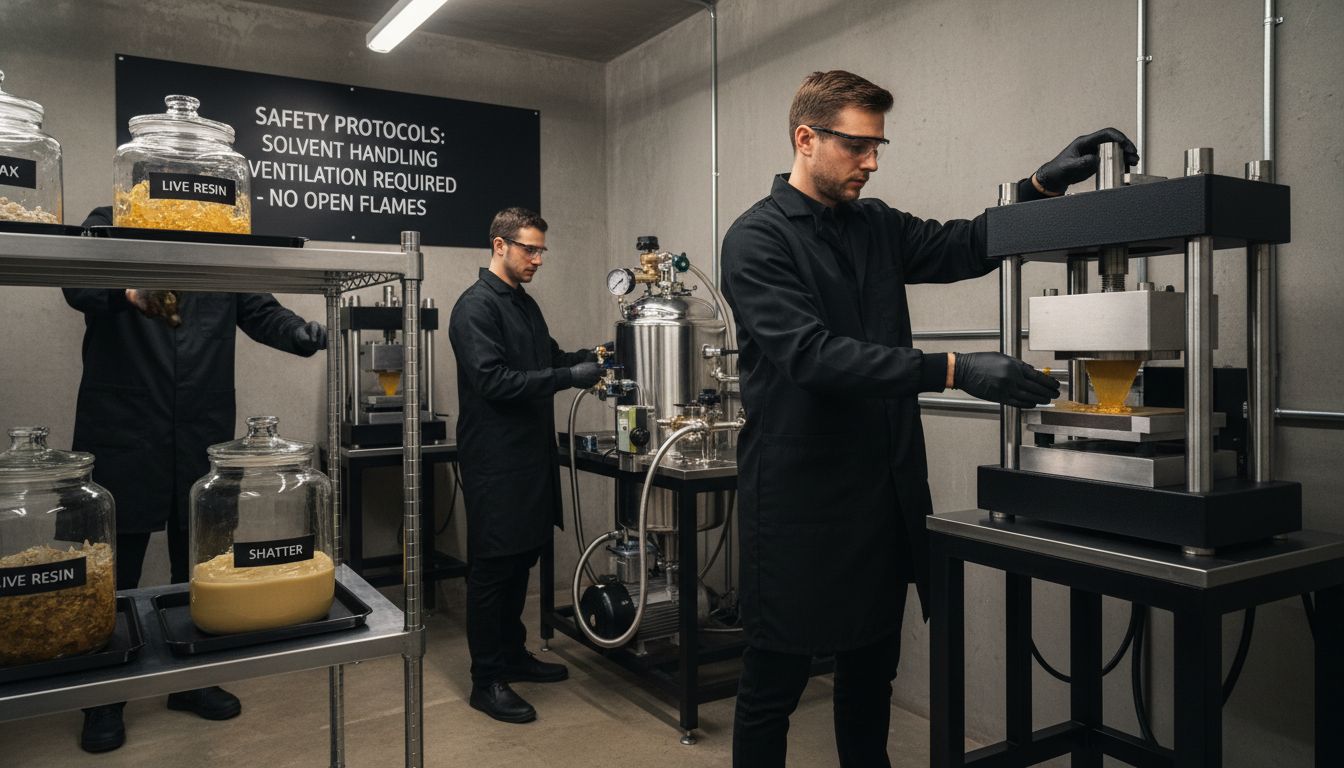What Is Cannabis Resin? Complete Breakdown Guide
Written by Trevor

Most people believe all cannabis resin is the same, but the truth goes much deeper. Research shows resin from the flowering tops contains far higher THC than other parts of the plant, upending common assumptions. As cannabis concentrates grow in popularity, understanding what resin really is and separating fact from myth matters more than ever. This article breaks down cannabis resin’s definition, exposes widespread myths, and gives you the insight needed to make informed choices.
Table of Contents
- Cannabis Resin Defined And Common Myths
- Major Types Of Cannabis Resin Explained
- How Cannabis Resin Is Extracted And Used
- Legal Status And Compliance Considerations
- Risks, Alternatives, And Usage Mistakes
Key Takeaways
| Point | Details |
|---|---|
| Cannabis Resin Complexity | Cannabis resin varies significantly across different parts of the plant, with the highest THC concentrations found in flowering tops. |
| Myth Debunking | Common misconceptions include uniform potency and safety of resin, which can lead to health risks if misused. |
| Resin Types and Extraction | Major types include live resin, shatter, and wax; extraction methods vary between solvent-based and solventless techniques, impacting quality. |
| Legal and Safety Considerations | Understanding legal regulations and potential risks associated with extraction methods is crucial for responsible production and consumption. |
Cannabis Resin Defined And Common Myths
Cannabis resin is a complex, sticky substance produced by the cannabis plant that captures the essence of its unique biochemical composition. According to Fire Marshal, this resin contains concentrated cannabinoids like THC, with its highest concentrations found in the flowering tops of the plant.
Contrary to popular belief, cannabis resin is not uniform across all plant parts. As research from PMC indicates, the resin extracted from flowering tops has significantly higher THC levels compared to other plant sections. This nuanced composition challenges the widespread myth that all cannabis plant materials produce equal potency.
Debunking Common Cannabis Resin Myths
Several persistent misconceptions surround cannabis resin that deserve careful examination:
-
Myth 1: All Resin Contains High THC Not true. Resin concentration and cannabinoid content vary dramatically across different plant parts and cultivation conditions.
-
Myth 2: Consuming Resin is Completely Safe Contrary to casual assumptions, cannabis resin can still pose potential health risks, especially when consumed in concentrated forms.
-
Myth 3: Resin Quality is Uniform Plant genetics, growing environment, and extraction methods significantly impact resin quality and chemical composition.
Understanding these distinctions helps consumers approach cannabis resin with more informed, nuanced perspectives. For those interested in exploring cannabis myths further, check out our comprehensive guide on cannabis myths.
Ultimately, cannabis resin represents a complex botanical substance that defies simplistic characterizations. Its intricate chemical profile demands respect, scientific understanding, and responsible consumption.
Major Types Of Cannabis Resin Explained
Cannabis resin comes in several fascinating concentrate forms, each with unique characteristics and extraction methods. According to PMC, the primary types include ‘live’ resin, shatter, and wax, each representing a distinct approach to capturing the plant’s potent compounds.
Understanding Cannabis Concentrate Varieties
Live resin stands out as a premium concentrate, extracted from fresh, flash-frozen plant material to preserve the plant’s original terpene profile. Shatter, in contrast, appears as a translucent, brittle substance that resembles amber glass. Research from PMC indicates that these concentrates can reach remarkable potency levels, with some products containing up to 90% THC content.
Key Types of Cannabis Resin
Here’s a breakdown of the most prominent cannabis resin types:
-
Live Resin Extracted from fresh, frozen cannabis plants Highest terpene preservation Most aromatic and flavorful concentrate
-
Shatter Glass-like, translucent concentrate Extremely high potency Brittle texture that “shatters” when handled
-
Wax Soft, malleable concentrate Varies in texture and color Easier to handle compared to shatter
For cannabis enthusiasts looking to dive deeper into extraction techniques, our guide on THCA rosin extraction methods offers comprehensive insights into the intricate world of cannabis concentrates.
Understanding these resin types requires appreciating the nuanced science behind cannabis extraction. Each type represents a unique intersection of botanical chemistry, technological innovation, and consumer preference, making the world of cannabis concentrates both complex and fascinating.

How Cannabis Resin Is Extracted And Used
Cannabis resin extraction is a sophisticated process involving multiple sophisticated techniques that transform raw plant material into concentrated compounds. According to PMC, extraction methods can be broadly categorized into two primary approaches: solvent-based and solventless techniques, each delivering unique characteristics and potency levels.
Extraction Methodologies
Solvent-based extraction represents a complex scientific approach, utilizing substances like butane, ethanol, and supercritical CO2 to isolate cannabinoids. These methods allow for precise separation of plant compounds, creating concentrated extracts with controlled potency. Research indicates that each solvent interacts differently with cannabis material, producing variations in final product quality and chemical composition.
Solventless and Solvent Extraction Techniques
Key extraction methods include:
-
Dry-Sieving Mechanical separation of trichomes Minimal processing required Preserves natural plant compounds
-
Rosin Press Uses heat and pressure No chemical solvents involved Maintains terpene and cannabinoid integrity
-
Ethanol Extraction Efficient cannabinoid isolation Versatile extraction method Used in various commercial products
For cannabis enthusiasts interested in understanding advanced extraction processes, our comprehensive guide on cannabis cannabinoid extraction offers deeper insights into these intricate techniques.
The extracted cannabis resin finds application in numerous products, including oils, edibles, tinctures, and topicals. Each product type represents a unique way of experiencing the plant’s potential therapeutic and recreational benefits, transforming raw botanical material into versatile consumer experiences.

Legal Status And Compliance Considerations
Navigating the legal landscape of cannabis resin extraction requires a comprehensive understanding of complex regulatory frameworks. According to California Department of Public Health, extraction methods are categorized into distinct regulatory classifications, including mechanical, chemical, and advanced technological approaches, each with specific compliance requirements.
Extraction Method Regulatory Classifications
The legal framework surrounding cannabis resin extraction is intricate and multifaceted. Extraction methods are rigorously classified based on their technological approach and potential safety implications. Regulatory bodies distinguish between mechanical/solventless techniques, chemical extractions using nonvolatile and volatile solvents, and advanced methods like supercritical CO2 extraction.
Safety and Compliance Guidelines
Key compliance considerations for cannabis resin extraction include:
-
Mechanical Extraction Lowest regulatory complexity Minimal processing requirements Typically involves manual or mechanical separation
-
Chemical Extraction Stringent safety protocols required Specific solvent management guidelines Extensive documentation and testing mandated
-
Hydrocarbon Extraction Requires closed-loop systems Strict worker safety regulations Explosion prevention protocols essential
For processors seeking deeper insights into regulatory compliance, our comprehensive guide on cannabinoid extraction processes provides extensive detailed information.
Understanding these legal nuances is crucial for responsible cannabis resin production. Oregon OSHA emphasizes the critical importance of implementing robust safety measures, particularly for hydrocarbon extraction methods that involve volatile solvents like butane and propane, highlighting the paramount significance of worker protection and systematic risk management.
Risks, Alternatives, And Usage Mistakes
Cannabis resin extraction and consumption come with a complex array of potential risks and critical considerations that consumers must carefully understand. According to PMC Research, cannabis concentrates present significant challenges, including potential contamination from residual solvents and pesticides, and dangerous production hazards like extraction-related explosions.
Primary Risks in Cannabis Resin Consumption
The extraction process itself introduces multiple potential health and safety risks. Chemical solvent extraction can leave behind harmful residues that compromise product safety, with some extraction methods posing more significant threats than others. Scientific research emphasizes that chemical solvents used in extraction can introduce contaminants that potentially impact consumer health.
Common Usage Mistakes and Alternatives
Key risks and recommended alternatives include:
-
Solvent Contamination Potential health risks from residual chemicals Can lead to unexpected physiological responses Requires careful product selection
-
Extraction Method Hazards Explosive risks during hydrocarbon extraction Potential for chemical exposure Complex safety management required
-
Safe Extraction Alternatives Supercritical CO2 extraction Solventless mechanical techniques Reduced contamination potential
For cannabis enthusiasts seeking to understand safer consumption practices, our guide on cannabis user privacy tips provides additional insights into responsible use.
Ultimately, understanding these risks requires a nuanced approach. Consumers must prioritize products from reputable sources, understand extraction methods, and remain informed about potential health implications. The key is education, careful selection, and a mindful approach to cannabis resin consumption.
Discover Premium Cannabis Resin Options Crafted for You
Navigating the complex world of cannabis resin extraction and types can feel overwhelming. This article sheds light on key challenges like understanding potency differences, extraction risks, and identifying quality resin products. If you want to experience the authentic benefits of cannabis resin without guesswork, choosing carefully sourced, lab-tested concentrates is essential. Whether you seek the rich terpene profiles of live resin or high-potency shatter, quality matters deeply.

Explore our curated collection at The THCa Prestige Vault – California Blendz where you can find premium, sustainably grown THCa flower and resin concentrates. Each product comes with transparent third-party lab results ensuring safety and potency. Start your journey confidently knowing you’re selecting from California’s finest. Visit California Blendz today to browse trusted cannabis resin options and learn more from The Founder’s Collection – California Blendz. Take control of your cannabis experience now with products that match the careful, informed approach you deserve.
Frequently Asked Questions
What is cannabis resin and what does it contain?
Cannabis resin is a sticky substance produced by the cannabis plant, primarily found in the flowering tops. It contains concentrated cannabinoids like THC, capturing the plant’s unique biochemical composition.
What are the common myths about cannabis resin?
Some common myths include the belief that all resin contains high THC, that consuming resin is completely safe, and that resin quality is uniform across different cannabis plants. In reality, cannabinoid levels and quality vary significantly.
What are the different types of cannabis resin concentrates?
The main types of cannabis resin concentrates include live resin, shatter, and wax. Live resin is extracted from fresh, frozen plant material, shatter is a brittle, glass-like concentrate, and wax is soft and malleable, varying in texture and color.
What methods are used to extract cannabis resin?
Cannabis resin can be extracted using solvent-based methods, such as butane or ethanol, or solventless techniques like dry-sieving and rosin pressing. Each method can produce different qualities and potencies of the final product.
Recommended
- 7 Smart Ways to Take a Cannabis Tolerance Break Effectively – California Blendz
- Exploring THCA Rosin Extraction Methods: A Comprehensive Guide – California Blendz
- Exploring the Top Cannabis Cannabinoid Extraction Processes: A Compreh – California Blendz
- Unlocking the Mysteries of Cannabinoid Isomerization: Exploring its Pr – California Blendz








